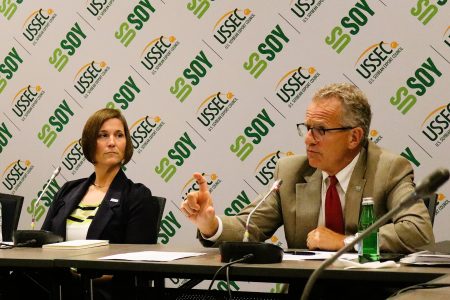Over 700 global stakeholders gathered in Washington DC to explore the future of sustainable soy. Hosted by the US Soybean Export Council (USSEC), the three-day Soy Connext 2025 highlighted US Soy’s expanding role in global food security and trade resilience.
The Trade Team Invitational opened the event with structured one-on-one meetings between US suppliers and international buyers. Delegates from 59 countries engaged in matchmaking sessions to forge new deals and deepen supply chain partnerships.
Trade teams also toured US farms, grain terminals, and processing facilities, gaining firsthand insight into the soy value chain. These visits reinforced U.S. Soy’s reputation for transparency, infrastructure, and quality.
USSEC CEO Jim Sutter emphasized the need to differentiate US Soy from other origins. He cited temperate climate, low carbon footprint, and consistent quality as key advantages.
“We want to be the soy everyone prefers,” Sutter said. “High nutritional value and sustainability are increasingly important to global buyers.”
Expanding crush capacity to meet global demand
Bruno Coletti of Cargill described U.S. Soy as a strategic asset in a volatile market. While Brazil leads in volume growth, U.S. Soy offers reliability and robust logistics.
By end-2025, ten new crush facilities will add 9 million tons of capacity, yielding 7 million tons of additional soybean meal. This expansion supports rising demand for animal protein in growth markets like China, India, and Southeast Asia.
Quality metrics setting US Soy apart
German Bosch of AG Com compared soybeans from major origins and affirmed U.S. Soy’s leadership in quality. He highlighted three key advantages:
- ✅ Mature infrastructure ensures efficient transport and minimal damage.
- ✅ Temperate climate produces soybeans with lower moisture and heat damage.
- ✅ Strict standards cap total damage at 3% and heat damage at 0.5%, compared to Brazil’s 8% and 1%.
U.S. Soy’s reputation for clean, uniform product continues to attract buyers seeking dependable supply.
Sustainability and collaboration drive future growth
USSEC also recognized 147 companies across 12 countries that now carry the ‘Sustainable U.S. Soy’ or ‘Fed with Sustainable U.S. Soy’ label. These firms reflect growing global demand for responsibly sourced ingredients.
Among the honorees are companies from Vietnam and Indonesia.
Sutter noted that sustainability is no longer optional. US producers lead with the lowest carbon footprint, driven by yield improvements rather than land expansion.
He also stressed the importance of collaboration. “Great things in business are never done by one person,” he said. “They’re done by a team.”
His message: connection, quality, and sustainability are the pillars of a resilient soy future.

